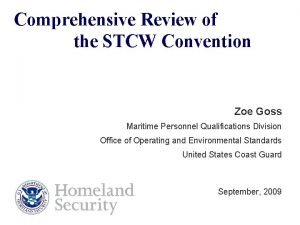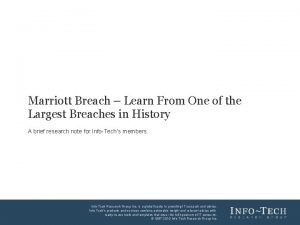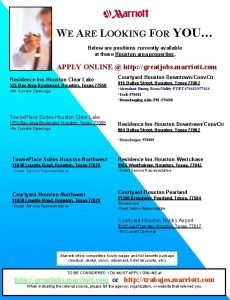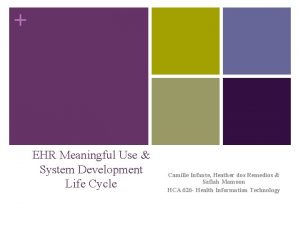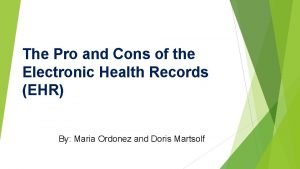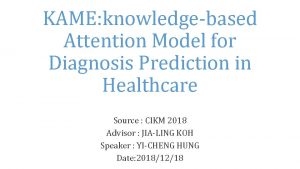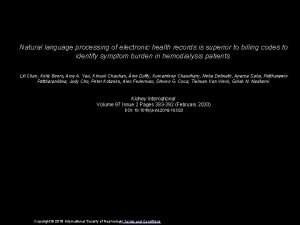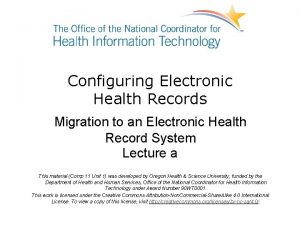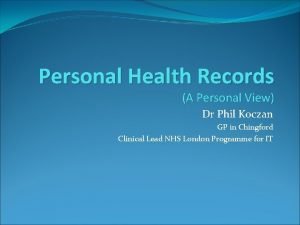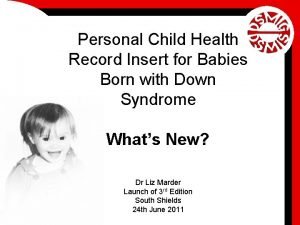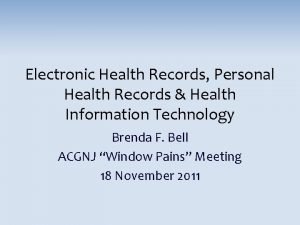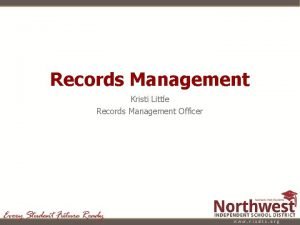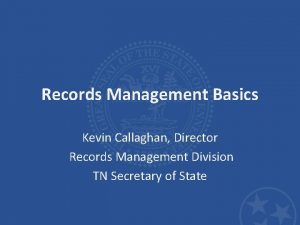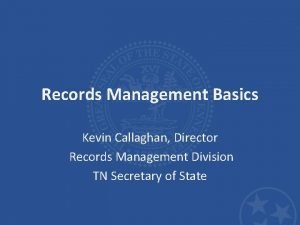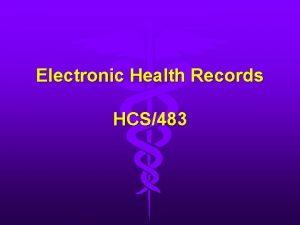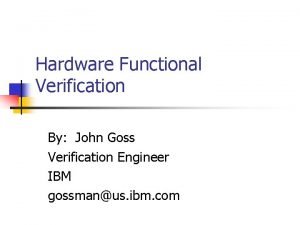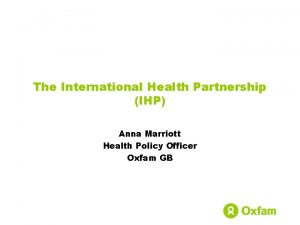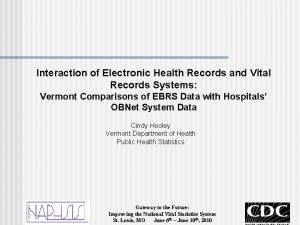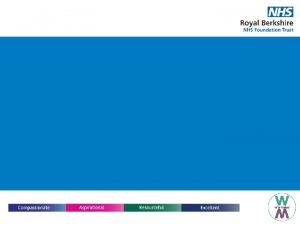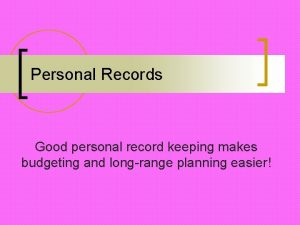Personal Health Records John Goss Scott Marriott Kevin


























- Slides: 26

Personal Health Records John Goss Scott Marriott Kevin Scharnhorst

Introductions

PHR – A Definition An electronic, universally available, lifelong resource of health information needed by individuals to make health decisions. Individuals own and manage the information in the PHR, which comes from healthcare providers and the individual. The PHR is maintained in a secure and private environment, with the individual determining rights of access. The PHR is separate from and does not replace the legal record of any provider. ” (2003, AHIMA)

PHR – Examples of • Paper based system stored in folders or binders in a physical drawer • Electronic scans stored in virtual file system on a computer, server or portable storage device • Portable devices such as a smart phone, personal digital assistants or memory devices • Internet-based personal health records (i. PHR)

Fundamental Requirements • Portable • Interoperable

Common elements needed • • • Personal demographic information General medical information Conditions Hospitalizations Surgeries Medications Vaccinations Laboratory test results Clinical tests Pregnancy History Family Medical History

US Market analysis • PHRs have been around in various forms since late 1990’s early 2000’s • As physicians converted to EMRs web portals started to be instituted (RWJF, 4) • Chronic disease management and consumerism fueled early attempts • First generation were labor intensive and provided very minimal value to anyone • Later generations have the ability to aggregate some data, to book appointments, may be able to process billing claims.

Historical progress • 2002 – Markle foundation established Connecting for Health to accelerate adoption of electronic health records • 2003 – AHIMA launched my. PHR • 2005 – AHIMA launched education presentation kit • 2008 – Vendors start offering solutions

PHR market – digitized and online • B 2 B model in B 2 C model out • Initial efforts aimed at consumer and failed • Great amounts of challenges in a nascent market – Technological – Highly complex – (Chilmark, 2010). • Most businesses offering directly to other businesses

PHR – Types (2010, Chilmark Research)

PHR market – 2010 • Fragmented • 100 -200 vendors say they sell PHRS • Focused on i. PHRs (internet based) – 20% of 200 i. PHRs • 40% of the 40 vendors are thriving • 35% treading water • 25% walking zombies (Chilmark, 2010) • No consolidation of models • No consolidation of fees • No “Home run” business case

Meaningful Use- Market trends • • Included in meaningful use language Under ‘Engage Patients and Families’ Signifies importance 2013 physicians to provide patient with a PHR • 2 -3 years away from trial stage to early adopter – niche specialty (Moor, Chilmark)

IT Underpinnings • Data – Traditional forms of healthcare data include claims information, laboratory and imaging results, treatment and pharmaceutical histories, and other indicators of patient’s medical history. • Infrastructure – Used to collect, process, and exchange data • Application – Combination of data and infrastructure used to present data to the user

IT Underpinnings (cont. ) Architecture 1 -Structure

IT Underpinnings (cont. ) Architecture 2 -Standards

IT Underpinnings (cont. ) Architecture 3 -Security

IT Underpinnings (cont. ) Provider -Tethered ($) PHR Component Clinical Data Repositories Acquisition Annual Payer-Tethered ($) Acquisition Third-Party ($) Annual Acquisition Annual $0 $0 $400, 000 $100, 000 $95, 000 $14, 000 $450, 000 $90, 000 $1, 700, 000 $930, 000 $0 $0 $57, 000 $40, 000 $8, 000 $20, 000 $4, 000 $6, 600, 000 $1, 300, 000 Medication Matching $0 $0 $0 $17, 000 Network Connectivity $0 $1, 000 Patient Matching $0 $0 $67, 000 $125, 000 PHR Data Repository $0 $25, 000 Results Answer Matching $0 $0 $17, 000 $15, 000 Results Name Matching $0 $0 $0 $460, 000 User Support $0 $2, 700, 000 $50, 000 $10, 000 $2, 300, 000 $3, 800, 000, $6, 600, 000 $1, 300, 000 $450, 000 $90, 000 $2, 800, 000 $3, 900, 000 $6, 600, 000 $1, 300, 000 $3 $4 $6, 600 $1, 300 Client User Authentication Core Data User Interface Data Center Doctor Matching Interfaces Secure Messaging Total Cost Single Application Cost Total Cost w/Application* Cost per user** Comp model for personal health records Center for information technology leadership (CITL) at Harvard Medical School

Patient/Consumer Perspective Networked Individuals as e-patients • • • 61% of total population – 83% of online population 64% of women; 57% of men 65% of whites; 51% blacks; 44% Hispanics Age – 72% of 18 -29 -year-olds – 71% of 30 -49 -year-olds – 59% of 50 -64 -year-olds – 27% of those 65 and older Skews upscale and educated Parents Source(s): http: //e-patients. net/, Rainie, Lee. The rise of the e-patient (MLA Conference) Oct 7, 2009

Patient/Consumer Perspective Interest in i. PHRs relatively high Source: Westin, Alan J. , Americans Overwhelmingly Believe Electronic Personal Health Records Could Improve Their Health, Markle Foundation, 2008.

Patient/Consumer Perspective Penetration still very low Too high, but… Source: North American Technoraphics Media, Marketing, Consumer Technology, and Healthcare Benchmark Survey, Forrester Research, Fall 2009

Patient/Consumer Perspective Those consumers with PHRs show significant health improvements Greater readiness to change unhealthy behaviors § 7. 5% increase of those in the preparation/action/maintenance stages of change vs. 5. 3% increase for control group Better preventive screening compliance §Control group had a compliance rate 8. 1% higher than the control group §Fewer missed days due to illness/absenteeism §Decreased number of missed work days by 10%, while control group increased by 33% Larger decreases §Depression: 2. 9% vs. 0. 9% §Stress: 3. 3% vs. 0. 5% Source: Web. MD Health Services Group, 2009

PHR market – Markets • Provider – Physician and organizational resistance – Cost of implementation – Product and Vendor immaturity • Employers – Manage insurance cost premiums – Complement health and wellness initiatives – Trust huge issue, no portability • Health Plans – In general a leading supporter of early adoption – Cost of implementation often a prohibitor

Health Plan Examples • Kaiser is the best example that was examined. Roughly 40% actively engaged. 3. 7 of 8 Million. • Blue Cross Blue Shield have gone from Web. MD to Google most recently according to John Moore (Chilmark Research)

PHR the Future Areas where the industry will focus • Rise of the PHS • Privacy • Data Aggregation • Business Case needs • Provider adoption • PHR development of content • Actionable data • Standards and governance • Consumer acceptance

PHR Future • 2 -3 years away • Must solve consumer trust, privacy and adoptions issues • Must begin to solve data aggregation issues • More consolidation of vendors, in and out • Immature product offerings along the lines of ‘who’ provides the PHR.

 Goss urbanite press
Goss urbanite press Jon goss
Jon goss Zoe goss
Zoe goss Gun control thesis statement
Gun control thesis statement Dentist john yelenic
Dentist john yelenic Marriott bsa audit
Marriott bsa audit Marriott corporate responsibility
Marriott corporate responsibility Casa magna marriott cancun
Casa magna marriott cancun Birchstreet marriott login
Birchstreet marriott login Marriott corporate headquarters
Marriott corporate headquarters Marriott data breach timeline
Marriott data breach timeline Marriott corp the cost of capital abridged case solution
Marriott corp the cost of capital abridged case solution Crystal ballroom marriott islamabad
Crystal ballroom marriott islamabad 700 convention way
700 convention way Www.greatjobs.marriott.com
Www.greatjobs.marriott.com O what is that sound analysis
O what is that sound analysis System development life cycle of electronic health records
System development life cycle of electronic health records Pros and cons of electronic health records
Pros and cons of electronic health records Electronic health records
Electronic health records Natural language generation for electronic health records
Natural language generation for electronic health records +electronic +health +records +migration
+electronic +health +records +migration Infinitivo, gerundio y participio practica
Infinitivo, gerundio y participio practica Adivinanzas higiene personal
Adivinanzas higiene personal Sariling personal na pahayag ng misyon sa buhay
Sariling personal na pahayag ng misyon sa buhay Personal health record definition
Personal health record definition Health triangle
Health triangle Personal child health record
Personal child health record


